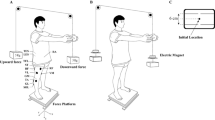Summary
A recent article by Crenna et al. (1987) has shown that fast, forward bending movements are accompanied by a backwards motion of the hips and lower limbs. The ongoing research presented in this brief note expands upon the experimental data described by Crenna and colleagues, concerning the postural activities associated with rapid forward bending in standing man. Our primary experimental tool is the computer simulation method, with the standing subject being represented by a double-joint system: the trunk is modeled as a rigid link mechanically coupled (via a “hip” joint) to the lower body link fixed to the ground (via an “ankle” joint). Each of the two joints in this system is independently controlled by a neurological control model for single joint movements, consisting of an idealized pair of antagonistic muscles (flexor and extensor), their common load, and proprioception from the muscle spindles. This model thereby integrates descending commands with proprioceptive feedback in controlling the joint movements. Our early simulation experiments determine a “reduced trajectory”, that is, the physical perturbation to the postural system, due to the voluntary movement, in the absence of any stabilizing activities. These simulation experiments clearly show that an important component of the backward movements in the hips and lower limbs during forward bending is indeed due to the mechanical (physical) coupling between the upper and lower body segments and thus not solely a consequence of the anticipatory postural muscle activity. Simulations also predict that any postural activities in the hips and lower limbs should be a two-fold process: first, some preprogrammed, descending control to the lower body would be required to actively enhance the passive, backwards motion (this is consistent with, though not strictly identical to, the hypothesis of Crenna and colleagues); secondly, there must be a subsequent activation in the anterior muscles of the lower body in order to arrest this backwards motion, since otherwise the uncountered momentum would carry the body backward to the floor in less than half a second after the upper body movement has terminated.
Similar content being viewed by others
References
Brenière Y, Do MC, Bouisset S (1987) Are dynamic phenomena prior to stepping essential to walking? J Motor Behav 19: 62–76
Crenna P, Frigo C, Massion J, Pedotti A (1987) Forward and backward axial synergies in man. Exp Brain Res 65: 538–548
Crenna P, Frigo C, Massion J, Pedotti A, Deat A (1988) Forward and backward axial movements: two modes of central control. In:VS, Gurfinkel ME, Ioffe J, Massion J eds.. Roll Stance and motion. Plenum Press, New York, pp 195–201
Hannaford B, Stark L (1985) Roles of the elements of the triphasic control signal. Exp Neurol 90: 619–634
Hannaford B, Kim WS, Lee SH, Stark L (1986) Neurological control of head movements: inverse modeling and electromyographic evidence. Math Biosci 78: 159–178
Ramos CF (1989) Mathematical modeling and computer simulations of the reflex control of voluntary movements. PhD thesis. Department of Biophysics, University of California, Berkeley
Ramos CF, Hacisalihzade SS, Stark LW (1990) Behavior space of a stretch reflex model and its implications for the neural control of voluntary movements. Med Biol Eng Comp 28: 15–23
Ramos CF, Stark LW (1987) Simulation studies of descending and reflex control of fast movements. J Motor Behav 19: 38–62
Ramos CF, Stark, LW (1988) Modeling the neurological control of human movements. J Motor Behav 20: 462–473
Ramos CF, Stark LW (1990a) Postural maintenance during movement: simulations of a two joint model. Biol Cybern (in press)
Ramos CF, Stark L W (1990b) Simulation experiments can shed light on the postural adjustments related to voluntary movements. In: Winters, Woo (eds) Multiple muscle systems: biomechanics and movement organization. Springer, New York
Stark LW (1968) Neurological control systems. Plenum Press, New York
Zattara M, Bouisset S (1988) Posturo-kinetic organization during the early phase of voluntary upper limb movement. 1. Normal subjects. J Neurol Neurosurg Psychiatry 51: 956–965
Zatsiorsky V, Selayanov V (1983) The mass and inertia characteristics of the main segments of the human body. In:Matsui H, Kobayashi K (eds) Biomechanics VIII-B. International series on biomechanics 4B. Proceed Eighth Intern Congr of Biomechanics, Nagoya / Japan. Human Kinetics Publishers, Champaign
Author information
Authors and Affiliations
Rights and permissions
About this article
Cite this article
Ramos, C.F., Stark, L.W. Postural maintenance during fast forward bending: a model simulation experiment determines the “reduced trajectory”. Exp Brain Res 82, 651–657 (1990). https://doi.org/10.1007/BF00228807
Received:
Accepted:
Issue Date:
DOI: https://doi.org/10.1007/BF00228807




